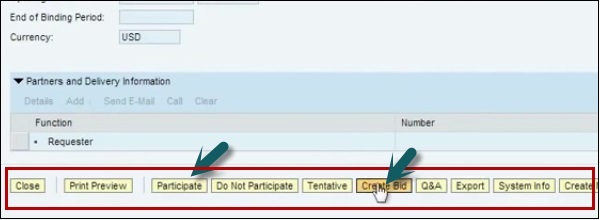
- SAP SRM - Home
- SAP SRM - Overview
- SAP SRM - Navigation
- SAP SRM - Functions
- SAP SRM - Software Components
- SAP SRM - Deployment Options
- SAP SRM - Contract Management
- SAP SRM - Creating Central Contract
- SAP SRM - Bid Invitation
- Quotation & Live Auction Cockpit
- SAP SRM - Procurement
- Invoicing And Purchase Order
- SAP SRM - Shopping Cart
- SAP SRM - Supplier Self-Service
- SAP SRM - Post Installation For LAC
- Configuring Single Sign-on
- SAP SRM - Supplier Evaluation
- SAP SRM - MDM Catalog Upgrade
- SAP SRM - Security
- SAP SRM - System Landscape
- Network & Communication Security
- SAP SRM - Auditing & Logging
SAP SRM - Bid Invitation
A bid invitation is defined as a request from a buyer to a supplier to submit a quotation for goods or services as per the mentioned criteria. Bid invitation is also known as request for quotation RFx.
A request for quotation RFx is an invitation sent to supplier by an organizations purchase department to submit RFx response for the supply of certain goods under specified terms and condition. RFx document contains information like vendors name, vendor's address, quantity of goods and delivery dates for the material. You can create RFx with reference to a purchase requisition and all the information is copied from the purchase requisition. When RFx is created without any reference, you can enter the details manually in RFx document.
Creating Bid Invitations in Bidding Engine
To create bid invitations for services and goods, buyers can use SAP Bidding Engine to create public and restricted bids. You can customize system to perform bid invitation automatically in the background for requirements where no source supply is assigned.
You can check assigned sources by going to SPRO → IMG → SRM Server → Sourcing → Define sourcing for product categories
Login to SRM system → SPRO → IMG
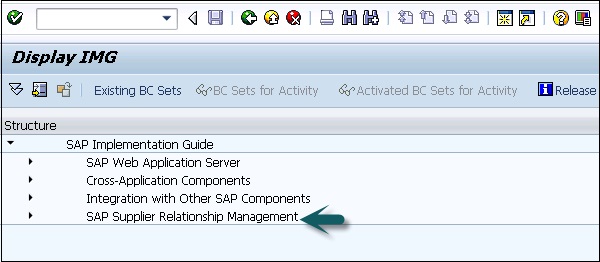

Here you can check sourcing for product categories −
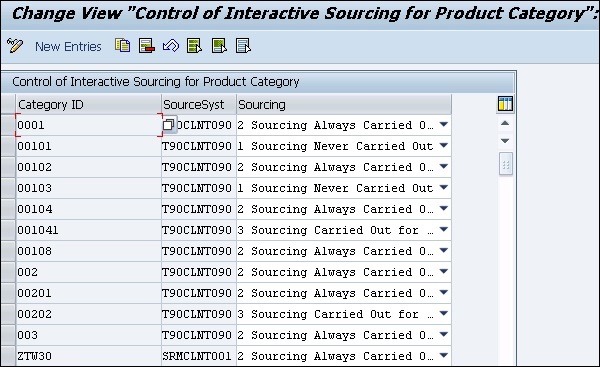
Types of Bid Invitation
In SAP bidding engine, you can create two types of bid invitations −
Public Bid Invitations
These bid invitations are available to all bidders via a web portal. Bidders can access the url available on web portal to login to SAP bidding engine and there they can enter the bids. If you want some specific bidders to send the bid, you can directly email them the bid invitation.
Restricted Bid Invitations
In restricted bid invitations, the hyperlink to login to SAP Bidding Engine is sent to some specific set of bidders via email. Bidders can login to Bidding Engine and enter the bid.
In addition to this, you can create emails using the Smart Forms feature −
Step 1 − To create a bid invitation, you have to login to the SAP Bidding Engine. You can search for existing bid invitations or create a new invitation.
Step 2 − When you create a new bid invitation, you have to mention the name and number range at the top.
Step 3 − Enter the basic data for bid invitation, this includes −
Type of Bid Invitation (public/restricted)
Product Category
Start Date and Time − When a bidder can enter the bid details in the system. When no time is mentioned, bidders can bid when the invitation is published.
End Date and Time − Bidders can submit their bids until this time period.
Opening Date and Time − This time is defined as the time when you can open and reject the bids.
End of Bidding Period − This allows the bidder to mention the end of bidding period till when that bid is valid.
Detailed Price Information − This condition can be used to allow bidder to put price scale.
Bidders/Bid − You can search for suppliers/bidders from the supplier directories and extend the bid invitation to these bidders in case of public invitation.
Step 4 − Similar way, you can define other fields like currencies in which bid is accepted and if the bidder can bid in any currency of their choice. You can also attach any additional documents you want to share with bid invitations.
Step 5 − Under Item data, you can fill item details by transferring items from a catalog or by transferring products from product master. Lot option can be used to group related items together.
Step 6 − When you enter all the required information in relevant fields, you can perform a check by clicking on Check button at the top of screen.
Step 7 − You can save your bid by clicking on Hold button.
Step 8 − When you click on Complete, it shows that the bid has been checked and it is ready for publishing.
Step 9 − You can select the Publish button to publish the bid invitation.
Step 10 − Go to SRM Portal → Strategic Purchasing → Strategic Sourcing
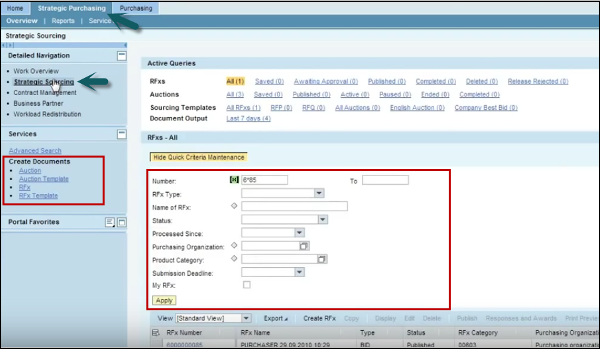
Step 11 − On the left side, you have an option to create RFx. Click on RFX and you will be prompted to select RFx type. Select RFx type and click on Start.
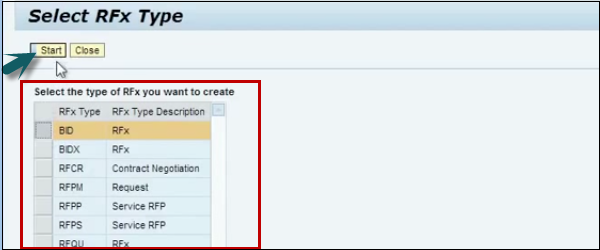
Step 12 − At the top, you can see basic data bout RFx like RFx#, Name, type, status, created by, etc.
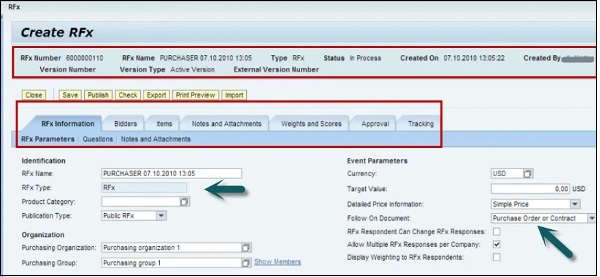
Step 13 − Under Event parameters, you can define the output field if it is a Purchase Order or a Contract.
Step 14 − Go to Bidders tab; here you can search bidders from internal or external directories.
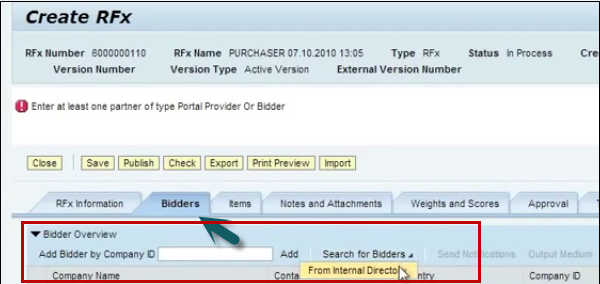
Step 15 − You can also type the bidder company id and click on Add button to add the bidders to the list.
Step 16 − Go to Items tab, enter item details like description, product category, quantity, Delivery date, lot and item type etc.

Step 17 − You can add any other notes and attachments. If you want some specific questions to be raised with the Bidder, go to RFx information tab → Questions → ADD Question.

Step 18 − You can find existing questions or can create new questions as per the requirement. To add the comment in bid, select the check box.
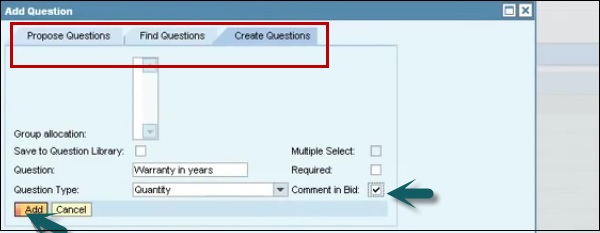
Step 19 − To add weight and score to the question, go to the tab and add weight. You can also assign percentage and value for which 100% score will be provided.
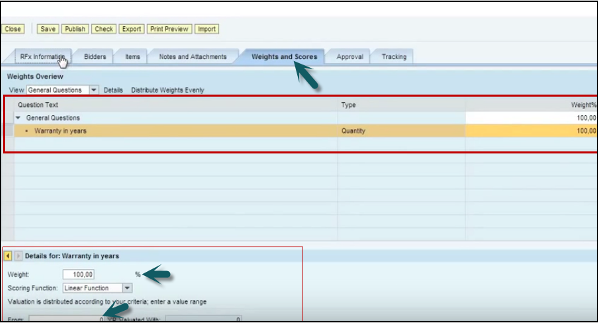
Step 20 − When all the details are entered, you can publish RFx. All the suppliers will get an email message.

Step 21 − All the documents and RFx details will be sent in attachment as per the configuration. You can also attach images of goods in RFx and the same will be received by suppliers in an email message.
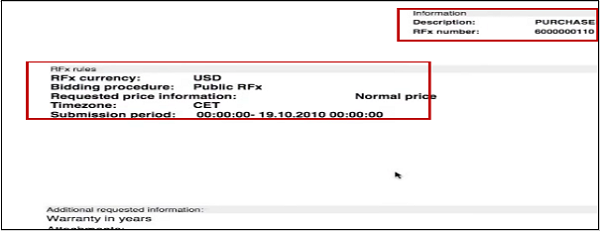
Step 22 − In the email message, a hyperlink is provided where bidders can login and enter the bid details. They can select RFx and submit a response.

Step 23 − To participate in bidding, click on the Participant button and the purchaser will be notified. To create a bid and enter the details, click on the Create Bid button.
